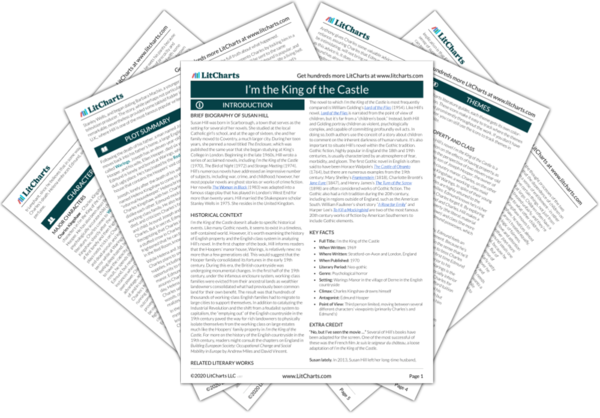Property and Class
Susan Hill’s novel I’m the King of the Castle is a meditation on the effects of having property, as seen from the perspective of two eleven-year-old children. Edmund is the son of Joseph Hooper, the owner of Warings, a large English country manor. Charles, on the other hand, is the son of Helena Kingshaw, a working-class maid whom Joseph hires to work at Warings. In spite of their young age, both…
read analysis of Property and ClassChildhood
I’m the King of the Castle is a book about children, but it’s not exactly a children’s book. Like another disturbing work about young people, William Golding’s Lord of the Flies, the novel paints a dark picture of human nature, suggesting that children—contrary to the way in which they’re often portrayed—are born with the capacity for cruelty, destruction, and evil. Hill’s novel revolves around two young characters, Edmund Hooper and Charles Kingshaw, whose…
read analysis of ChildhoodFear and Psychological Manipulation
I’m the King of the Castle is full of frightening moments for its characters. The main character, Charles Kingshaw, spends most of the novel in a frightening new place, Warings manor, while the other main character, Edmund Hooper, torments him with nasty pranks designed to confuse and terrify him. Even as Charles becomes more familiar with life at Warings, he continues to be consumed by fear, almost as if his emotions have a…
read analysis of Fear and Psychological Manipulation
Imprisonment and Escape
I’m the King of the Castle examines different kinds of physical and psychological imprisonment. Warings, the large English manor house to which Charles Kingshaw and Helena Kingshaw move, could be considered a prison: it’s large, bleak, isolated from the rest of the world, and controlled by people who enforce rigid hierarchies. By this logic, Charles Kingshaw can be seen as a prisoner: he’s trapped in a lonely, miserable place, where his only companion is…
read analysis of Imprisonment and EscapeNature
Throughout the novel, Hill depicts nature in two opposing ways: in its wild forms, and as dead, controlled, or otherwise “tamed.” Hang Wood (the forest that surrounds Warings), is an example of “wild nature,” while the Hooper family’s vast moth collection, which has been carefully preserved, arranged, and classified, is the defining example of “tamed nature.” Charles Kingshaw, the novel’s main character, is strongly associated with nature in its wild and unrestrained forms…
read analysis of Nature






